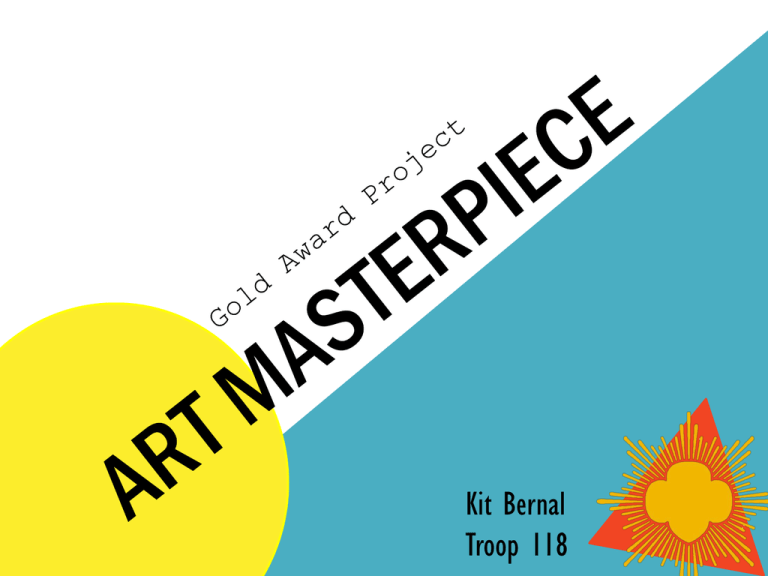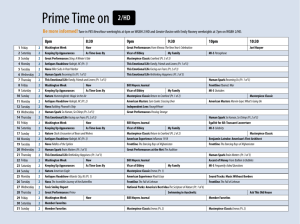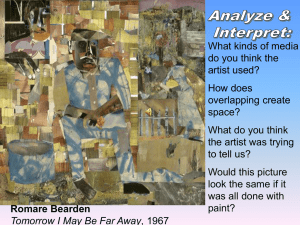Proposal Powerpoint - Bernal Art Masterpiece
advertisement

Kit Bernal Troop 118 Art Masterpiece: What Is It? Art masterpiece is a national volunteer run program designed to enhance children’s knowledge of art through critical viewing, art history, and a related hands-on project. Students learn about a variety of art movements, styles, terms, and specific artists, while also creating their own projects that are flexible and easily tied into current school curriculum and Colorado based standards. “The purpose is not Marisa Hambleton, program coordinator and parent volunteer at Broadmor Elementary to teach specific art techniques, but rather to increase the child's awareness of art and enhance visual literacy.” How Does It Work? Art Masterpiece looks at one prominent artist or work per lesson, which is used to teach about art terms and concepts such as design, color, artistic movements, and different media. Following the brief and interactive lesson, students create a work of art that is inspired by the one shown, and used to reinforce the specific techniques discussed. This can be easily customized to any grade level and tied into curriculum. Because Art Masterpiece can be planned so far in advance, it requires no actual artistic prowess or knowledge from Those teaching it, only a sense of enthusiasm Kindergarten, Paul Klee’s “Senecio, head of a man” Paper Collage Terms taught: Shape, portrait, symmetry Sixth Grade, Traditional Chinese Calligraphy Paper lantern and ink calligraphy Terms taught: positive and negative space, contrast The Gold Award Process \1. Project Planning and Identification of Issue Issue: Lack of Art Education for Home-Schooled Students > No Set Curriculum or Time Project: Art Masterpiece Program > Introduction to Art Styles, Movements, and famous Artists 2. Community Outreach Advisors: people connected with the homeschool program, parents Team: Local art stores, etc. 3. Creating A Plan Institute a supplemented and pre-planned art/art history program within the homeschool to increase awareness of art and artists, foster creativity, and relate art back to other meaningful educational subjects. How Would We Do It Here? Because the homeschool not only plans so far in advance but cycles through the plans, a relating “Art Masterpiece” curriculum could be used indefinitely. Unlike traditional Art Masterpiece programs, the ability to tie it so directly into the curriculum allows teachers to do the projects directly in class, and related to the current unit. Each Art Masterpiece lesson includes > Specific Work of Art or Art Movement (primary source) > Art vocabulary and ideas related to Art Movement (pre-written lesson) > Plan for related, grade level appropriate project > Example of project As this is my project, I would be able to plan according lessons for the units planned, and write the curriculum Common Theme: Southwestern Native American Cultures Primary Source (Woven Navajo Blanket) Project: Navajo Blanket (kids get pre cut out shapes and arrange them in a pattern, or could color pre printed blanket) Art Terms: Shapes, Symmetry, Color Scheme Why is it Important? In most public schools, art education and funding are the first to be cut. While this is not as much of an issue within homeschooling programs, art is still often not an emphasized subject due to lack of resources. Art literacy improves > social skills However, art is especially important in the formative elementary years for development and > motor development growth. Art Masterpiece is an easy program to institute and sustain, due to the fact that lesson > curiosity and motivation to plans can be made for months in advance, and it requires no artistic prowess to teach and learn > critical thinking skills little time in the classroom (typically an hour lesson per month). > creativity and problem solving > intuition and emotional development Art Masterpiece is also highly customizable, allowing it to be catered to different (right brain development) age groups, curriculums, and Colorado Based Standards. Students who participate in arts are twice as likely to read for pleasure are three times more likely to > be recognized for outstanding school attendance > be elected to a class office position are four times more likely to > be recognized for academic achievement > participate in a math or science fair > perform community service Source: americansforthearts.org “Involvement in the arts is associated with gains in math, reading, cognitive ability, critical thinking, and verbal skill. Arts learning can also improve motivation, concentration, confidence, and teamwork.” Fran Smith, Edutopia contributor











